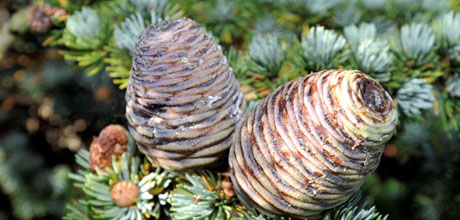Conifer Cultivar a Feature of Collection
This article was first published on 23 May 2012.

Cedrus
Crowning the conifer cultivar collection at the north end of the rock garden is an old, blue, cascading cedar. For over 40 years the tree has observed many changes at Dunedin Botanic Garden, the latest being the collection developing around it, enhancing beauty, colour and shape.
Cedrus
Cedrus can be distinguished from other conifers by the leaf arrangement and cone structure. Evergreen needles are borne in rosettes on short, spur-like growths. Female cones are barrel shaped, and held upright on the branches. These break into pieces, dispersing the winged seed, leaving the centre still attached like a sharp wooden candle. Male cones are more like overgrown catkins, smothered in yellow pollen in autumn.
Cedrus atlantica
The Atlas cedar, Cedrus atlantica, forms forests on the slopes of the Atlas and Riff Mountains of Algeria and Morocco. These beautiful pyramidal trees grow up to 40m high with a trunk 2m in diameter. The blue Atlas cedar, now known as C. atlantica (Glauca Group), was introduced into Britain in the early 1840s, and has been grown in parks and large gardens ever since.
Cedrus atlantica ‘Glauca Pendula’
This cultivar was selected in about 1900 for its arching branches and blue tinged foliage. It makes a beautiful, year round specimen tree. The branches are quite flexible and can be trained over a bank or wall, as an archway, or more usually staked as a standard, then trained to cascade towards the ground like a living waterfall. Upon reaching the ground, it will flow in a straggly prostrate manner.
Robyn Abernethy is the Rock, Water & Alpine Collection Curator at the Dunedin Botanic Garden


